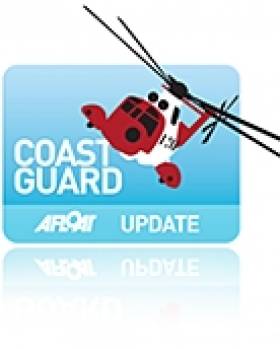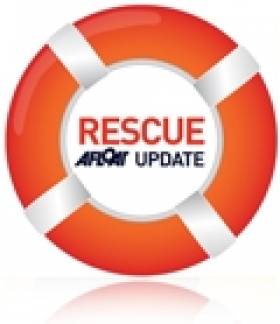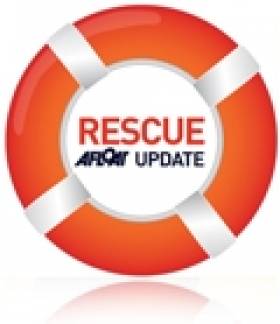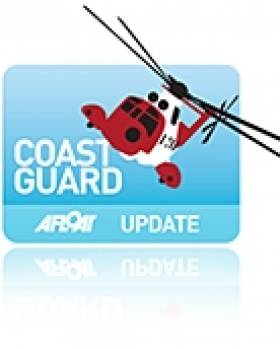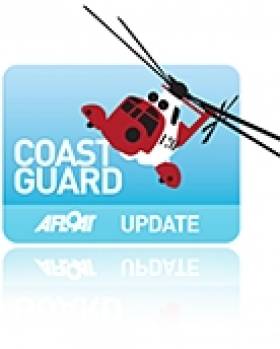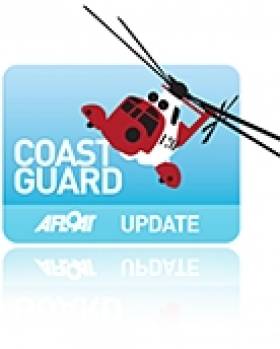Displaying items by tag: Irish Coast Guard
Fisherman Airlifted to Galway Hospital
#RESCUE - The Irish Examiner reports that a man has been airlifted to hospital after taking ill on a fishing vessel off Galway yesterday Friday 21 September.
The man reportedly experienced chest pains on board the fishing boat off the coast of Spiddal.
Galway RNLI's lifeboat was dispatched to the scene to attend to the man before he was airlifted by Irish Coast Guard rescue helicopter to Galway University Hospital. His condition is as yet unknown.
Mayo Mountain Rescue Breaks Record for Call-Outs on Croagh Patrick
#COASTGUARD - Mayo's mountain rescue unit has reported its busiest ever period with an "unprecedented" 14 call-outs in just six weeks, according to The Irish Times.
Irish Coast Guard personnel assisted Mayo Mountain Rescue on four of the total, helping to winch people who had fallen while descending Croagh Patrick on the south side of Clew Bay.
The injury toll on the mountain - accounting for 10 of the 14 recovery efforts - has prompted Mayo County Council to seek planning permission for a helicopter landing pad higher up the 2,500-foot peak.
The news comes just after Enniskillen RNLI was names the busiest lifeboat station in the island of Ireland, with 23 launches between its two inshore lifeboats and two rescue water craft over the summer months.
Surface Search for Missing Diver Winds Down
#MISSING DIVER - Teams were still searching yesterday at a wreck site off Cape Clear for a diver missing since Tuesday, according to The Irish Times.
A Defence Forces spokesperson told the paper that a sonar device would be employed to scan the seabed for any sign of 54-year-old Reinhardt Teschke, who failed to resurface from a 90m dive on the wreck of British merchant vessel the Minnehaha.
As previously reported on Afloat.ie, Baltimore RNLI launched both its inshore and all-weather lifeboats to the scene south of Balitmore Harbour in West Cork on Tuesday evening to search for the German diver, one of a party of three at the wreck site.
Irish Coast Guard helicopter Rescue 115 and the Naval Service vessel LE Ciara were also involved in the surface search, which was set to be wound down yesterday.
Donegal Coastguard's Cliff Rescue Service May Be Scrapped
#COASTGUARD - The Donegal Democrat reports that the northern county may soon lose the cliff rescue service supplied by the Bunbeg coastguard unit.
Irish Coast Guard spokesman Gerard O'Flynn confirmed that the recent Fisher Report commissined by Minister for Transport Leo Varadkar "recommends that the Bunbeg unit should just continue as a coastguard boat and search team and no longer offer the cliff rescue element of their operation."
He added: "There has been no decision taken on this. It is only contained in the report, it is at discussion level."
As previously reported on Afloat.ie, the same 'value for money' report has recommended the closure of both coastguard radio stations at Malin Head and Valentia Island.
The Bunbeg unit, which comprises 23 volunteers in total, covers much of the county's northwestern coastline from Rosbeg to Horn Head which has become a popular spit for climbers both on the mainland and offshore on the likes of Tory Island and Arranmore.
Irish Coast Guard's New Smartphone App Aims to Save Lives
#COASTGUARD - A new smartphone app from the Irish Coast Guard could save dozens of lives, as the Irish Independent reports.
The new technology allows the coastguard to track vessels at sea, and automatically prompts a search and rescue effort if they do to return to port as expected.
"The whole idea is to encourage mariners to inform us when they are going out to sea," said Malin Head district commander Derek Flannery. "When and where they plan to go, when they plan to return and how many are going."
It is hoped that the new app will encourage seagoers to me more conscious of altering emergency services to their movements, in the wake of very recent tragedies off Spanish Point in Co Clare and the Beara Peninsula in West Cork.
They system works by asking mariners to input details about their excursions - such as destination and expected return time - into the app before they set off. The app will also track the vessel's movements via GPS.
"We'll text the boater to remind them to check in but if we don't get a response we can send out a crew," added Flanagan.
According to TheJournal.ie, the iPhone-only app is currently being trialled by sailors, divers, fishermen, powerboaters and pleasurecraft users throughout Ireland, and there are plans to develop the app for a range of smartphones.
“Getting to casualties early is the key for our search and rescue units," said Dublin Bay North TD Seán Kenny. "This new app has the potential to get our resources on-scene as quickly as possible which will in turn save lives.”
Teen Injured in Water at Kilkee Pier
#RESCUE - A teenage boy was airlifted to hospital yesterday after an incident at Kilkee Pier in Co Clare.
The 17-year-old, understood to be from Limerick, sustained a serious injury after diving from the pier into shallow water.
The Irish Coast Guard station at Valentia Island co-ordinated the recovery effort, with the local coastguard and paramedics sent to the pier after the alarm was raised at lunchtime yesterday.
As The Irish Times reports, the new Shannon rescue helicopter was also tasked to the scene amid concerned that the teen had injuries to his head, neck and back.
Rescuers waded into the water to recover the young man, who was treated at the scene for a serious head wound before being driven to the local golf club to the makeshift helicopter landing spot, from where he was airlifted to Galway University Hospital for treatment, according to RTÉ News.
Kilkee Marine Rescue Service chairman Manuel Di Lucia said that authorities "need to consider" the absence of a dedicated helicopter landing site in Kilkee closer to the pier.
Rescuers Guided to Donegal Swimmer By Woman With Binoculars
#RESCUE - The Irish Times reports on the rescue of a swimmer in distress off the Donegal coast thanks to the help of a woman with binoculars.
And the RNLI has paid tribute to the Malin Head coastguard unit for its knowledge of the area which was instrumental to the postive turn-out.
The man had been swimming off Five Fingers strand in Inishowen on Friday afternoon when he was washed out more than one-and-a-half miles into the sea.
The Malin Head unit of the Irish Coast Guard immediately co-ordinated the rescue effort, which saw both the Sligo coastguard helicopter and Lough Swilly RNLI lifeboat dispatched to the scene.
In an echo of June's 'miracle rescue' of a man in Cork Harbour after he was spotted by telescope, rescuers were assisted by a woman with an elevated view on the shore who spotted the swimmer and guided them to his location.
The man was quickly airlifted to Altnagelvin Hospital in Derry for treatment. He was said to be very traumatised after the incident.
“The outcome could have been different but for the local knowledge these guys have,” said Lough Swilly lifeboat spokesman Joe Joyce.
As previously reported on Afloat.ie, the coastguard radio stations at Malin Head and Valentia are both under threat of closure following a 'value for money' review of the State's marine rescue services.
Valentia and Malin Head Stations Now Both Under Threat
#COASTGUARD - Coastal communities in Kerry have joined those in Donegal protest against plans to close the Malin and Valentia coastguard stations.
In last Friday's This Island Nation, Tom MacSweeney discussed the attempts by management at the Irish Coast Guard to centralise radio operations in Dublin, commenting on the "vital component" of the stations' staff's local knowledge.
As previously reported on Afloat.ie, Minister for Transport Leo Varadkar said he would begin an action plan due in October to deal with issues outlined in a recent 'value for money' report which may require "tough decisions", including the closure of a coastguard radio station at Malin or Valentia.
Donegal TD Charlie McConalogue had already asked the Government for assurances on the future of Malin Head, which he said "has provided and invaluable service for over a century".
But the Sunday Independent has learned that now both stations are earmarked for closure, and reports that the Valentia Save Our Station group is concerned the minister is looking at an "alternative technical solution" by installing coastguard equipment from the west coast in his own constituency in Blanchardstown.
All this is despite the scheduled installation of hundreds and thousands of euro worth of new equipment in the Valentia station, which currently handles two-thirds of all major search and rescue operations annually, according to the Irish Examiner.
The change in plans has come as a surprise, the Examiner says, after similar proposals under the previous government were halted following pressure from backbench TDs.
Shannon Helicopter Goes The Distance for Donegal Rescue
#COASTGUARD - The Shannon-based Irish Coast Guard rescue helicopter was dispatched to the Donegal coast on Friday night to rescue a young boy seriously injured in a farming accident.
As the Clare Herald reports, Rescue 115 - which only entered service a month ago - was called on to make the long-distance journey after the Sligo coastguard chopper was grounded by technical problems.
The mission put Shannon's new Sikorsky S92A craft's long-range capabilities and specialist medical equipment to the test, as it flew from Clare to Tory Island via Sligo General Hospital to evaculate the six-year-old boy, airlifting him to Letterkenny General Hospital for treatment.
As previously reported on Afloat.ie, the Irish Coast Guard took delivery of the new chopper at its Shannon base earlier this year as part of the rescue service's €500 million deal with CHC Ireland to revamp the aircraft fleet. Shannon is the only base to receive a brand new helicopter as part of the contract.
Equipped for dedicated search and rescue operations, the Sikorsky S92A provides coverage for deep Atlantic Ocean missions, services Ireland's offshore islands and provides rescue cover on the west coast from Cork to Galway.
Howth Coast Guard Rescues Faller from Cliff Path
#RESCUE - The Howth Coast Guard Cliff Rescue team and Irish Coast Guard helicopter Rescue 116 were tasked yesterday evening (26 July) to the cliffs in Howth to assist a woman who fell from the cliff path at Whitewater Brook.
The tourist in her 20s apparently fell some 20 feet from the path while descending to the beach.
Due to the location, members of the public witnessing the incident were unable to get a phone signal and had return to the top of the cliff path to alert the emergency services.
Once tasked the team arrived quickly at the scene, and with the assistance of the helicopter winchman, the woman was treated for spinal injuries as a precaution by coastguard paramedics before being airlifted to Tallaght Hospital.
The teams thanked the quick actions from members of the public which enabled them to respond quickly, and reminded anyone who sees someone who needs help on cliffs, in the water or on the beach to call the emergency number at 999 or 112.






























